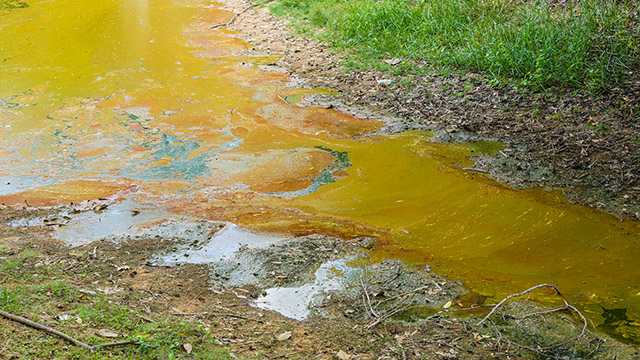
As I began research on this article, I wondered what it would be like to go through what the citizens in Flint, Michigan have experienced every day since 2014. As Americans, many of us don’t think too deeply about the source of our tap water. So, I spent a day, just one day, paying close attention to my water use. Taking a mental note of all of the different ways that my family and I could be harmed if the water that came out of the tap was dangerous. On that evening, after serving dinner, I watched my son fill up his cup with water. The vast importance of the situation that has occurred and is still occurring in Flint hit me hard, and I felt as if the wind had been knocked out of me. Each day I’d pour through reports about children whose lives have been forever changed for the worse just by drinking tap water. Then each evening, I’d watch my son fill his cup from our tap again. As a result of the accumulating information, I’d find that tears would suddenly stream down my face. The very tap water that so many of us use daily to drink, clean our dishes, and bathe made them sick. Watching him fill his cup last night, outrage replaced the sadness that had been settling in my belly during the research process for this piece. I wondered what I would do if my child began exhibiting alarming symptoms (bursts of anger, hair loss, rashes, and a decrease in cognitive ability). The parents in Flint, Michigan don’t wonder. They have lived with that horrible reality, and still do so today.
At the ending of April in 2014, Darnell Early (the State Emergency Manager for Michigan) was able to override local regulatory policies, and change the source of water for the city of Flint. It has been readily admitted that this change was to save the state money. Residents began to get their water from the Flint River rather than the Detroit Water System. By that summer, complaints began pouring in about problems with the water. Residents reported that the water smelled foul and was making people sick. Physical reactions included, though were not limited to, rashes and hair loss. By September, the citizens of Flint were instructed to boil tap water before drinking it, because tests revealed both e Coli and Coliform bacteria in the water. On October 1st of that year, General Motors announced that the company would no longer be using water from the Flint River, after workers took note that water from the location was corroding parts used to manufacture engines.
Three months later, Mayor Dayne Walling of Flint issued the following statement: “I want to assure everyone that the city is sensitive to the public’s concerns.” Mayor Walling went on to say that, “The city water is safe to drink. My family and I drink it and use it every day.” However, on the same day, the city’s Water Department sent customer notices to the effect that water in Flint was in violation of the Safe Drinking Water Act due to maximum contaminant levels for trihalomethanes (TTHM), which can cause liver, kidney and nervous system damage.The mayor’s announcement was as follows: “Sick and elderly people may be at risk, but the water is otherwise safe to consume.” On the 12th of January, 2015, when Detroit offered to reconnect Flint to their water for free, the city refused. At another meeting that same month, citizens showed up complaining of multiple symptoms; again including the formerly mentioned hair loss, vision and memory problems and rashes.

It was at yet another Flint meeting in January that LeeAnne Walters, mother of four children, brought bottles of water from the tap in her home, located on the south side of Flint. The picture below is of her showing the bottles to Darnell Early’s replacement as Emergency Manager, Jerry Ambrose.
When Mrs. Walters’ water was finally tested, approximately six weeks later, the levels of lead discovered was 104 parts per billion (ppb). The Environmental Protection Agency has emphasized that although no levels of lead are safe, the threshold deemed acceptable by federal standards is 15 ppb. Stephen Rodrick of Rolling Stone magazine reported that the City of Flint offered to fix her pipes, but in return required that she sign a no-harm agreement. According to John McQuaid of Smithsonian Magazine, “Hundreds of other Flint residents also complained about nasty, non-potable water and health problems, but even then, Flint officials insisted the lead problem was limited to the Walters’ household.” Interestingly enough, the family’s pipes were plastic. McQuaid continued, “At a City Council meeting, one Flint official intimated that Walters and her neighbors were spiking their own water just to draw attention to themselves.” Wow. This non-potable (i.e. not suitable for drinking) water is still currently the only substance coming out of taps in the city.
In her article, titled “Dirty Water,” author Sarah Houlton of Chemistry World wrote about how the dangerous situation in Flint occurred in the first place. She reported that it was when the water source was switched that residents began to report milky-looking water, roughly a week afterward. Houlton writes that this was caused by an “orthophosphate coating, put on by inhibitor-treated water from the Detroit system, starting to flake off the pipes.” The hydrants were flushed in an attempt to clear the water, but this merely accelerated the removal of the protective coating. Flint residents now noticed a light brownish tint. “The corrosive water started to work on the rust on the internal part of the water mains,” she explains. “They flushed again, but that merely aggravated the situation and turned the water deep brown. With the old lead pipes now unprotected, lead started to leach into the water.”
In the same article, author Houlton wrote that, “Lead is not involved in any of the human body’s biochemical processes, but it is capable of mimicking other bivalent metals that are cofactors to enzymatic reactions, notably calcium, iron, and zinc. It binds to the enzymes, but does not activate them, thus halting their normal activity. It is profoundly neurotoxic, and can cross the blood–brain barrier by mimicking calcium, where it interferes with neurotransmission, impacts the growth of neurons, and can damage the myelin sheaths around those neurons.” The long-term effects for residents are horrifying. In an appearance on CBS, author Jonathan Lapook speaks with Dean of Global Health at the Mount Sinai School of Medicine, Dr. Philip Landrigan. The doctor explains in the interview that, “Even low levels of lead (especially if exposure to low levels continues over many months) is going to cause some degree of brain damage to at least some of the children who have been exposed. That’s a big deal.”
In an article titled, “Who Poisoned Flint, Michigan?” Steven Rodrick wrote that, “Flint has seen a spike in the number of cases of Legionnaires’ Disease, a severe type of pneumonia, usually spread by bacteria in water vapor. The number of cases in Genesee County, where Flint is located, has gone from 6 to 13 to 87 from June 2014 to November 2016, roughly during the same time Flint began using water from the Flint River.” Amidst the horrible long-term effects that so many will suffer in this middle-American city, and in light of the terrible way in which local and federal agencies handled this crisis, it is important to note that Americans citizens did not give up, but spoke up. They supported one another. In February of 2016, 300 plumbers from the United Association Local 370 came to Flint in an effort to help residents and to donate and install new sinks. Elyse Wanshel of The Huffington Post reported that, “Plumbing Manufacturers International donated the faucets, which cost about $100 a pop according to ABC12, which is a price tag many residents of Flint cannot afford.” Michigan radio reported that the plumbers, “have been going door-to-door making sure that faucets are filter-ready since October.” Although this didn’t solve the problem entirely (because many of the homes have setups in which filtration couldn’t be installed), but it did help many tremendously. Throughout this travesty, it is nice to see Americans helping other Americans. This help has come in many forms, including individuals who spoke up when the local and federal government agencies responsible for protecting citizens were ignoring the problem. But not all government agents were so unhelpful.
Miguel Del Toral is a manager for the Midwest Water Division. Although some would say that Del Toral was simply doing his job, even those who did so at first were eventually silenced when LeeAnne Walters reached out to him for help. He quickly responded; writing to state aides saying, “Given the very high lead levels found at one home and the pre-flushing happening in Flint, I’m worried that the whole town may have much higher lead levels than the compliance results indicated.” He shared his information with the EPA at once. On July 1, 2015, the Director of the EPA’s Midwest Division, Susan Hedman, said that the report was premature. She said that an official report would be submitted, “when the report has been revised and fully vetted by EPA management.” Not to be dismissed so easily, Mr. Del Toral appealed straight to the Michigan Department of Environmental Quality (MDEQ) to take seriously the extremely high lead levels found in the Walters’ home. they responded that the elevations were to be expected based upon the seasonal change. Unfortunate as this was, Del Toral has been praised by the residents of Flint for his tireless efforts.
In August of that year, Professor Marc A. Edwards of Virginia Tech’s Department of Civil & Environmental Engineering began an independent study with his students on Flint’s water. The study showed that the water in the Flint River was 19 times as corrosive as Detroit tap water. Even though this additional study provided proof, a spokesman for the MDEQ disputed the findings.
This link to the WaPo offers a glimpse at the amount of lead found in the water in Flint. Professor Edwards wasn’t the only expert who had shocking findings from their field of expertise. In September of that same year, Dr. Mona Hanna-Attisha, Director of the Pediatric Residency program at Hurley Medical Center, announced that her research showed that there had been a rise in the number of children in Flint under age 5 with elevated blood lead levels. She reported that since the change in water supply the number had even tripled in some cases. Dr. Sanjay Gupta, Ben Tinker and Tim Hume, each of CNN fame, reported that Dr. Attisha found, “In some neighborhoods, it actually tripled. (In) one specific neighborhood, the percentage of kids with lead poisoning went from about 5%, to almost 16% of the kids that were tested.” she went on to point out that, “it directly correlated with where the water lead levels were the highest.”
On January 7th of last year, the chief medical executive in Michigan finally admitted the danger and began advising those in Flint to use only filtered or bottled water. A link for the aide that former President Barack Obama signed off on is detailed in this link.
The manner which the Flint crisis was handled by government at all levels has left Flint residents skeptical of news that their drinking water now meets EPA safety standards. An article was published titled “Flint Water Lead Amounts Improve Below Federal Limits,” by CNN’s Steve Almasy. Dated Wednesday, January 25, 2017, the author reports on a study from, “the period beginning July 1 and ending December 31.” The report found levels of lead were 12 parts per billion or lower in 90% of the samples taken, significantly lower than the action level of 15 ppb.” Distrust is so high, again, because residents have been told repeatedly throughout this crisis that the water was safe even when it was not.
 The people of Flint and the surrounding areas have not had reliable safe drinking water come out of their taps since 2014. During this period, bureaucrats of every rank have cut corners, lied to, and betrayed the citizens that they were elected or appointed to care for. There was a significant period of that time where residents were still expected to pay their water bills, in spite of the fact that the water was poisoning them. Moreover, as Pastor Allen Overton of the Flint-based Concerned Pastors for Social Action said, “Telling people the water was safe when it wasn’t created this disaster in the first place. Given the history of the State’s deception about the water, I’d hope they’d be proceeding with more caution, rather than making statements that may worsen the community’s deep distrust of the government.”
The people of Flint and the surrounding areas have not had reliable safe drinking water come out of their taps since 2014. During this period, bureaucrats of every rank have cut corners, lied to, and betrayed the citizens that they were elected or appointed to care for. There was a significant period of that time where residents were still expected to pay their water bills, in spite of the fact that the water was poisoning them. Moreover, as Pastor Allen Overton of the Flint-based Concerned Pastors for Social Action said, “Telling people the water was safe when it wasn’t created this disaster in the first place. Given the history of the State’s deception about the water, I’d hope they’d be proceeding with more caution, rather than making statements that may worsen the community’s deep distrust of the government.”
Currently, at the Federal level, the Trump administration has assured citizens that the funds promised by Obama’s administration in the amount of $120 million will be paid to help the city. On the state level, Gov. Rick Snyder’s has asked for a $56.3 billion budget in order to aid citizens with water needs and provide services for those affected by excessive levels of lead. However, many have pointed out that the situation that arose in Flint could happen anywhere in America. “In Dirty Water,” Sarah Houlton again tried to make clear, “While the acute situation in Flint was extreme, elevated lead levels in drinking water is far from an isolated issue.”
The children affected by this outrageous crisis will never be the same. Their lives are irrevocably altered, and this is due to government ineptitude and disregard on both local and federal levels. As all levels of government involved in this horrific situation scramble to try to fix the poisoned water of Flint, the citizens are still left with without access to one of the most basic services upon which all Americans depend in order to survive: safe running water. In Flint, families won’t be guaranteed this basic need for years to come. At the beginning of this piece I wondered what my reaction would be if, as a parent, I was faced with the situation so many in Flint deal with every day. I’d like to think my reaction would be similar to LeeAnne Walters’. I think that we all would. It is no secret that we live in a country that is divided on many issues. We all want our nation to be strong, but we seem to differ on the paths to take in order to strengthen America. I surmise that no matter where you stand, we all believe that we have the right to safe drinking water. We all have the right to keep our family safe. To provide them with a basic human need: water.
 I find myself utterly horrified that it will be years before Flint will have safe water from its taps, and this occurred primarily because local and federal agencies refused to listen. I find it terrifying that a manager can be appointed in an emergency situation with little in place assuring that the citizens will be protected. The possibility such an appointment could be made skirts the basis of the democracy that American government is based upon. These choices were made for the citizens of Flint by someone that they had no opportunity to vote for or against. I am disgusted that the residents of Flint had to pay outrageous prices for water that was poisoning them, water that they have to pay for again since all aide with water bills has been halted. I am frustrated that the people living in Flint did not seem to be at the top of the list when it came to receiving immediate help to solve the infrastructure problems that have lead to sickness and death. Last but not least, I am chilled to the core of my being that such pipes still crisscross this country. Miles and miles of lines zig–zagging across the nation, right under our feet. These pipes are wreaking havoc on a city called Flint, a havoc that could at any time be wrought on any of a number of cities all over America. Wrought on families. All over America. Families like mine. And yours.
I find myself utterly horrified that it will be years before Flint will have safe water from its taps, and this occurred primarily because local and federal agencies refused to listen. I find it terrifying that a manager can be appointed in an emergency situation with little in place assuring that the citizens will be protected. The possibility such an appointment could be made skirts the basis of the democracy that American government is based upon. These choices were made for the citizens of Flint by someone that they had no opportunity to vote for or against. I am disgusted that the residents of Flint had to pay outrageous prices for water that was poisoning them, water that they have to pay for again since all aide with water bills has been halted. I am frustrated that the people living in Flint did not seem to be at the top of the list when it came to receiving immediate help to solve the infrastructure problems that have lead to sickness and death. Last but not least, I am chilled to the core of my being that such pipes still crisscross this country. Miles and miles of lines zig–zagging across the nation, right under our feet. These pipes are wreaking havoc on a city called Flint, a havoc that could at any time be wrought on any of a number of cities all over America. Wrought on families. All over America. Families like mine. And yours.














